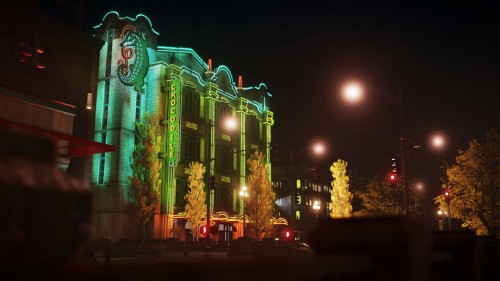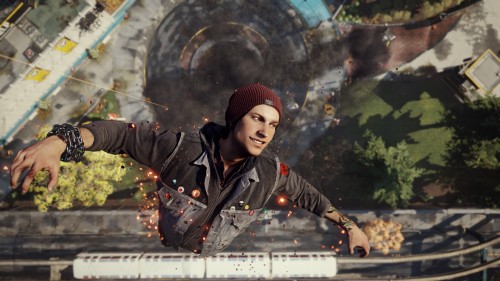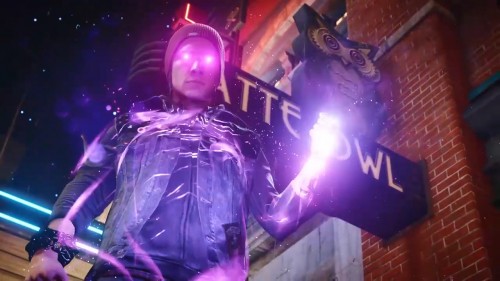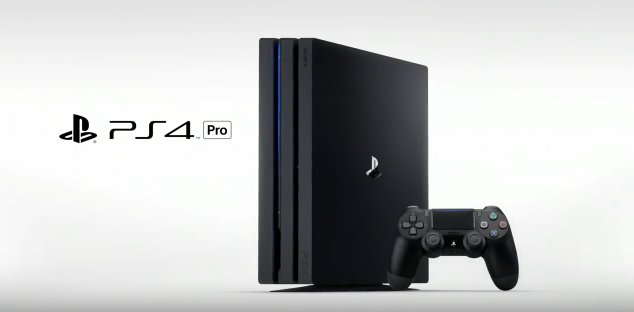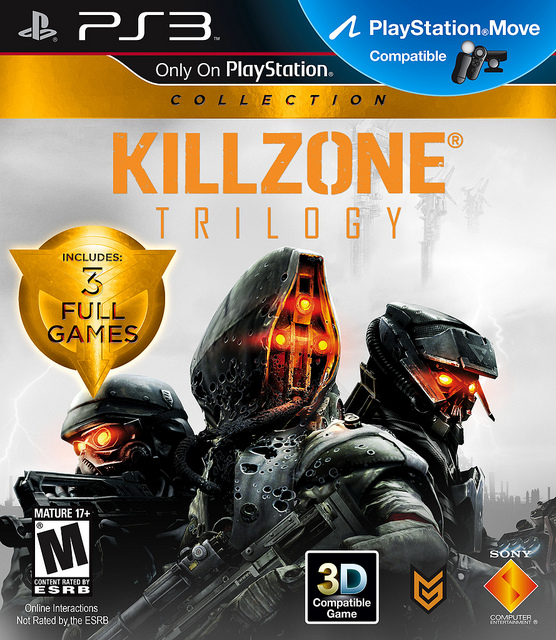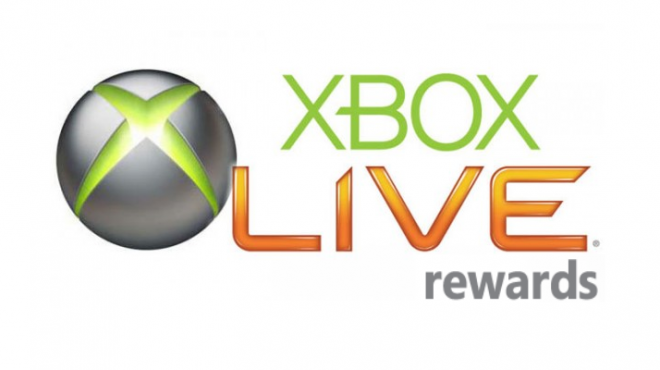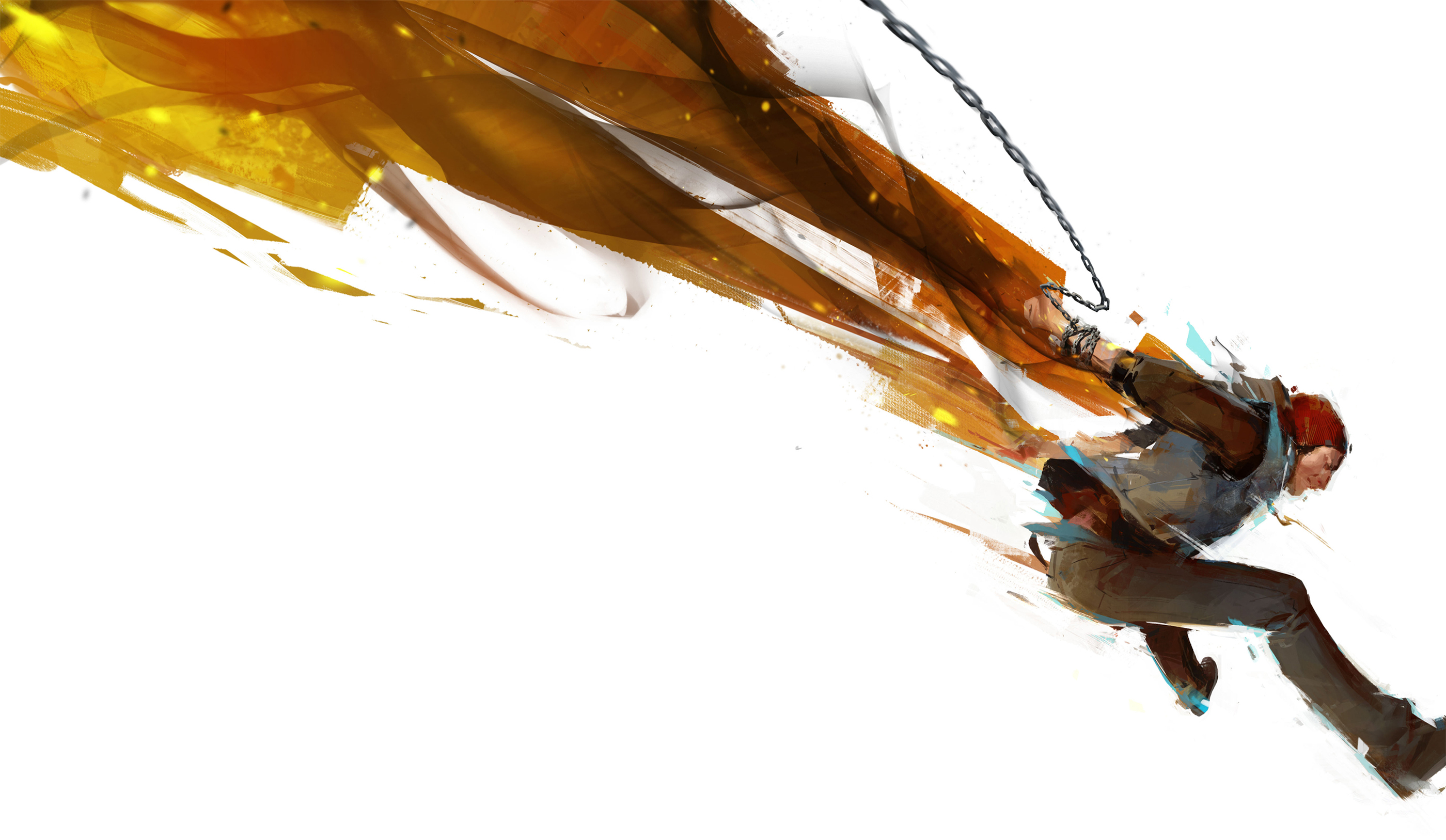
There’s certainly room in the PS4’s release line-up at the moment for some heavy-hitter titles, as Xbox One has already dropped the massive Titanfall onto hordes of fans. Infamous: Second Son is the second ‘major’ first-party release since the launch title Killzone: Shadow Fall, so expectations have high for the threequel to justify the purchases of so many Sony fans. Therefore, it gives me great pleasure to report that Second Son does not disappoint, either as a continuation of the Infamous series or a demonstration of the power of PS4.
Second Son follows the ‘Good Karma’ ending of Infamous 2, which (spoilers) presented players with the choice of either wiping out all super-powered individuals in the world (‘Conduits’) or becoming a monster that would eventually kill all regular people (end spoilers). While the second option would undoubtedly have produced a darker and perhaps more interesting scenario, Second Son retcons matters somewhat and clarifies that only some Conduits were killed. A new government agency, the Department of Unified Protection (DUP), is set up to defend against future Conduit incidents by arresting and containing any individuals who display unnatural abilities. Over time, prejudice and fear build up among the populace against Conduits, in a situation pretty much reminiscent of X-Men’s premise.
Seven years after the last game, a rebellious graffiti artist, Delsin Rowe, witnesses a DUP prisoner breakout, and upon coming into contact with one of them, realises he has the ability to absorb Conduit abilities from other people. Unfortunately, the DUP have been taking lessons from every other evil-government-agency in fiction ever, and their leader, herself a Conduit able to control concrete, needlessly interrogates members of Delsin’s Akomish tribe and leaves them critically injured. To heal them, Delsin must journey with his brother to the DUP’s headquarters in Seattle, to absorb their leader’s concrete ability.
Second Son shifts the series’ tone slightly – rather than fighting crime (although you still can in a limited capacity), you’re fighting against ‘the system’ and creating an uprising through your actions. While civilians on the street still take notice of your actions and praise you for being good (or lambast your evil ways), the atmosphere of the game lends a slightly different progression to it all. Whip out your powers at the start of the game and you’ll immediately be met by screams, people sprinting away and a quick visit from a DUP armoured van. However, if you free a few districts, complete some of the story and generally avoid acting like a dick, you’ll find yourself landing from a 10-story drop to the sound of light applause, phone cameras and the maybe some people admitting they’re beginning to doubt the DUP’s authority.
It’s kind of weird going from two fictional locations in the previous games (Empire City and New Marais) to the very real Seattle, although you’d be hard pressed to recognise it. While famous streets and landmarks like the Space Needle are present, the city’s bridges have been torn apart, DUP staging areas litter the streets and concrete spires jut-out amongst the cityscape.
This is also stunningly rendered and pretty, of course, but where this game really starts to impress is in how Delsin can traverse and interact with the environment. Parkour and wall-climbing is still available, as it was a key part of previous-protagonist Cole’s gameplay, but it’s slow and awkward compared to the new options available.
Over the course of the game, Delsin acquires three non-conventional, and visually impressive, powers – Smoke, Neon and Video. Smoke allows Delsin to discorporate and fly through vents, whooshing to the top of buildings with ease. Neon grants him super-speed, even allowing him to run up walls, and Video summons digital wings that can glide over short distances. The really cool part is how you power up each of the abilities – by drawing in each of their elements in the environment. Watching each of these elements weave around Delsin and the world is one of the exceptional parts of the visual design. Neon signs, video screens and chimneys litter the city and can all be sucked dry for their power-y goodness, but only Smoke allows you to get more inventive. There are dynamic situations where you can create smoke to absorb – from destroying vehicles and machines to coaxing enemies to throw smoke grenades.
This all makes Delsin a much more versatile protagonist than pretty-much-just-electricity-powered Cole ever was, but combat remains fairly similar. Just as in the first two games, melee combat is always an option, but most of the time you’ll find yourself lobbing off power-shots at a distance. Smoke provides harder-hitting firey volleys and missiles, while Neon powers allow for greater precision. Video gives Delsin rapid-fire blasts, with a few other random abilities like invisibility. The problem is that the game doesn’t throw a lot of variety at you with its enemy types. Every baddie has the same concrete-theme, just with different levels of powers, except for a couple of inventive boss battles (one of which literally has to teleport you to a video-game inside the video-game in order to provide a larger threat).
Aside from the main storyline, the rest of the game is tied up in an optional ‘take back the city’ style side-game, composed of several different types of missions. Seattle is divided up into sections on the map, each with their own DUP headquarters, surveillance and side missions. Destroying cameras, honing in on audio logs and uncovering hidden DUP agents all have to be performed to lower the DUP’s control over each section. Get it low enough and you can provoke a ‘showdown’, which summons a force of DUP soldiers to destroy before they leave the area altogether.
These side-tasks are passable in and of themselves, but they do get repetitive by the sixth or seventh time you find yourself going through the exact same motions. One exception is the spray-painting activities, which admittedly are very gimmicky, but satisfy on a ‘hey, neato!’ level. You litereally have to hold your controller sideways like a spray-paint can, shake it up (hearing the controller rattle inside) and then spray over graffiti stencils while your controller glows the appropriate paint colour.
The main drawbacks of the game are the limited progression and aging ‘Karma’ system, left over from previous titles. As Delsin gains a new power, like ‘Neon’, he’s immediately thrown into a mission where he has to find ‘blast cores’ to give him that power’s range of abilities. From then on, these abilities can be upgraded with ‘blast shards’ into more powerful forms, but you more or less have full access to what that power has to offer from the get-go, which detracts from the game’s pacing. Upon gaining access to a power, I was able to free city sections until I’d collected more than enough blast shards to max out everything available, and breeze through the next part of the story.
Capping progression is the Karma system – which unlocks certain tiers of abilities only when you achieve a good enough ‘Hero’ or ‘Infamous’ rating. Like so many good/bad blue/red systems of the past, you’re constantly monitored as to how you act – if you kill civilians, destroy property and execute enemies, you’ll gain evil karma. Restraining bad guys, healing the sick and turning water into wine will gain you good karma. Major boosts of karma are provided by key story decisions, which are as clear-cut good/evil as you can imagine, and ultimately you can gain one of two different endings depending on which side of karma you ended up on. It’s a system whose flaws were evident all the way back in the first BioShock, let alone a next-gen system seller, and it feels like it’s only here because the last two games featured it
Finally, special mention has to go to one of the elements of the presentation I haven’t mentioned yet – the character models and facial animation. On the lead characters like Delsin and Reggie especially (but also side characters like Betty), the work is just phenomenal. From time to time you can catch little glances, half-smiles, and just tiny facial tics that make these characters seem so much more real – it’s almost in the L.A. Noire category of realism (and that game literally just video’d actors faces and stuck them in the game).
There’s just so much cool stuff in Infamous: Second Son, from the weird and wonderful powers to the stunning visual quality and the fun ways to get around Seattle, that cement it (no pun intended) as the stand-out title to show off your PS4. The game is held back by a couple of key elements which are still mired in the past, but largely this is a fun, fresh adventure that will dazzle you with its technology.
Amazing visuals | Cool world interaction | Weird, fun powers | Good story
Progression and Karma system feel dated

